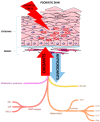Oxidative Stress as an Important Contributor to the Pathogenesis of Psoriasis
- PMID: 32867343
- PMCID: PMC7503883
- DOI: 10.3390/ijms21176206
Oxidative Stress as an Important Contributor to the Pathogenesis of Psoriasis
Abstract
This review discusses how oxidative stress (OS), an imbalance between oxidants and antioxidants in favor of the oxidants, increased production of reactive oxygen species (ROS)/reactive nitrogen species (RNS), and decreased concentration/activity of antioxidants affect the pathogenesis or cause the enhancement of psoriasis (Ps). Here, we also consider how ROS/RNS-induced stress modulates the activity of transcriptional factors and regulates numerous protein kinase cascades that participate in the regulation of crosstalk between autophagy, apoptosis, and regeneration. Answers to these questions will likely uncover novel strategies for the treatment of Ps. Action in the field will avoid destructive effects of ROS/RNS-mediated OS resulting in cellular dysfunction and cell death. The combination of the fragmentary information on the role of OS can provide evidence to extend the full picture of Ps.
Keywords: antioxidants; oxidative stress; psoriasis; reactive oxygen species/reactive nitrogen species.
Conflict of interest statement
The authors declare no conflict of interest.
Figures

References
Publication types
MeSH terms
Substances
Grants and funding
LinkOut - more resources
Full Text Sources
Medical

